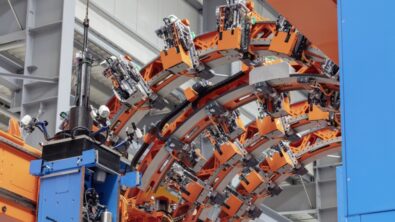Providing advanced digitalization and utilization with smart manufacturing

Technological innovations are rising, with productivity and business growth driven by the demand for mass customization and a requirement to converge technological advancements for innovative manufacturing infrastructures – smart manufacturing.
Smart manufacturing provides digitalization
At its core, smart manufacturing is a digital approach that helps companies optimize the manufacturing machine process, from executing manufacturing to extending service life. In addition, it creates a growth path for a dynamic marketplace, offering advantages to improve manufacturing throughput, uptime, and performance and reducing costs, overhead, operations and capital.
These ground-breaking capabilities empower smart manufacturing to allow machine manufacturers and designers to create a benefit by closing the loop between manufacturing operations and engineering.
Machine builders are implementing the following capabilities to enable smart manufacturing:
Connectability – A machine builder (OEM) allows machines to communicate with other machinery in their plant.
Adaptability – Smart machines identify upstream products and processes changes to alter dynamic operating conditions.
Predictability – Simulation and predictability of a machine’s performance in the field requires a high-fidelity digital twin.
Extendability – Predictive maintenance and adaptive performance can extend a machine’s life in the customer facility. The goal is to provide value to the manufacturing customer, thus optimizing cash flow.
Leveraging the digital twin with manufacturing digitalization
Smart manufacturing brings intelligence into every facet of the manufacturing process, surrounding the Internet of Things (IoT), Industrial Internet of Things (IIoT), and Industry 4.0. It integrates intelligence into machines, parts, materials, products, buildings, and the supply chain. Also, it applies that intelligence within a connected, open end-to-end process and infrastructure.
A digital twin is essential to implement smart manufacturing. It must encompass the mechanical, electrical, and programmable logic control (PLC) that enables a complete method to machine simulation. For example, when creating a machine tool component, it is necessary to inspect the manufacturing process for describing the data measured and collected to make traceability and close-the-loop process based on a highly functional digital twin.
Then it’s essential to link the product’s digital twin with the machine’s digital twin. Finally, it’s crucial to manage manufacturing operations to promote efficiencies by coordinating all activities to deliver the correct parts on time.
New advancements in part manufacturing, including additive manufacturing, higher performance multi-axis and combination mill-turn machining centers, require CAM software to maximize production capacity. Companies are also incorporating MBD into 3D models to leverage the information into automated inspection programs.
A staple in today’s manufacturing environment is robotics. This technology includes robotic machining and human-assist robots (cobots). The smart manufacturing solution includes integrating advanced robotics to simulate robot performance and integration on the factory floor.
Advanced plant level simulation capabilities track and trace materials through the factory from raw material to project rack to machine and optimize the layout to decrease high traffic areas and dead zones.
Smart manufacturing addresses the immense complexity of the machine bill-of-materials (BOM). Each function needs to view the BOM with purpose and traceability back to the single source of truth. This objective requires advanced analytics and capabilities to schedule, manage, and execute with quality.
All these abilities are helping companies adopt innovative processes for improving the overall performance of the machine, refining products processes, resolving failures and improving machinery operations.
Industry trends motivating change for machinery suppliers
Technological innovations are motivating industrial machinery companies to realize Industry 4.0. As a result, the following trends are re-shaping the engineering, manufacturing and service operations for machinery suppliers:
• Consumer-driven customization – Machines are now automating processes to help companies economically expedite the delivery of goods to the end-user. Overall trends in the consumer market define what machinery customers need. The consumer product development cycle compresses with smaller lot sizes and shorter product life spans. So, machinery customers need more flexible and adaptable machines to an ever-changing product mix with customized features or functions that require machine builders’ rapid innovation.
• Smart machines – Machinery component suppliers have completely embraced IoT-enabled devices. However, they must take advantage of available information. Input/output channels and various communication protocols, like wireless 5G, provide an order of magnitude increase in information flow. Therefore, automation code developers must choose which channels to use while building more intelligent machines.
• Hyper-automation – Discrete programming allows machine users to gain knowledge from IoT information. Hyper-automation requires large amounts of data and cloud-based analytics to accelerate machine behavior learning and performance to automate machine functions. Also, hyper-automation is enabled by low-code tools that help machine users mine data analytics for business processes, including manufacturing optimization, engineering reliability, and cost reductions.
• Global, highly innovative competition – The challenge is for more flexible, agile startup companies that begin with machine learning, unhindered by existing business processes or legacy customer engagements. Some offer production-as-a-service and others innovative software-enabled service monitoring tools and machine optimizations – even on competitor’s machines.
A machine builder must possess an all-inclusive approach to smart manufacturing, enabling machine manufacturers, designers and engineers to create more value to their machines and manufacturing process through multiple high-tech solutions. Possessing an executable digital twin is essential, along with the software implementing all phases in the manufacturing process: creation, execution and service life.
Siemens’ software solutions
Siemens’ Xcelerator portfolio helps companies of all sizes create and leverage digital twins that provide organizations with new insights, opportunities, and automation levels to drive innovation.
For more information on Siemens Digital Industries Software products and services, visit siemens.com/software or follow us on LinkedIn, Twitter, Facebook and Instagram.
Siemens Digital Industries Software – where today meets tomorrow
Related link:
Getting smart: How smart manufacturing is changing the way we do business


